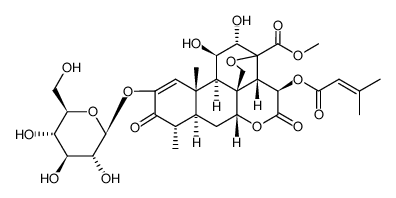| Description |
Brusatol, isolated from the Brucea javanica plant, inhibits Nrf2.
|
| Related Catalog |
|
| Target |
Nrf2[1]
|
| In Vitro |
A potential therapeutic application of an Nrf2 inhibitor such as Brusatol is the downregulation of Nrf2 pathway components in cells harboring constitutively high levels of the transcription factor. Brusatol provokes the depletion of Nrf2 via a mechanism that is not dependent on Keap1 and the proteasomal and autophagic protein degradation systems. Brusatol provokes a rapid and transient depletion of Nrf2 protein, through a posttranscriptional mechanism, in mouse Hepa-1c1c7 hepatoma cells. Brusatol also inhibits Nrf2 in freshly isolated primary human hepatocytes[1]. To explore the possible synergistic cytotoxicity of Brusatol (BR) in combination with CDDP, the study investigates the effects of Brusatol and CDDP cotreatment on CT-26 cell viability using an MTT assay. CT-26 cells are treated with various concentrations of Brusatol (0.05, 0.15, 0.45, 1.35, 4.05 and 12.15 μg/mL) and CDDP (0.05, 0.15, 0.45, 1.35, 4.05 and 12.15 μg/mL) for 48 h, either alone or in combination. Following treatment with Brusatol and CDDP for 48 h, the viability of CT-26 cells is reduced in a dose-dependent manner, with IC50 values of 0.27±0.01 and 1.44±0.22 μg/mL, respectively. When Brusatol is combined with CDDP at a constant concentration ratio of 1:1, cell growth inhibition is markedly enhanced compared with single-agent treatment; the IC50 value of Brusatol and CDDP cotreatment is 0.19±0.02 μg/mL[2].
|
| In Vivo |
To explore the anticancer effect of Brusatol in vivo, A549 xenografts grown in nude mice are used as a model. Nude mice are injected with A549 cells to induce tumor growth, followed by a single i.p. injection of 2 mg/kg Brusatol. Tumors are isolated 24 h or 48 h postinjection. Nrf2 protein levels are significantly decreased at 24 h or 48 h postinjection, indicating that Brusatol is able to reach the tumor tissue and inhibit the Nrf2 pathway. To measure tumor growth, two different experiments are performed. In the first experiment, once the tumor size reaches an average of 230 mm3, DMSO, Brusatol (2 mg/kg), Cisplatin (2 mg/kg), or Cisplatin (2 mg/kg) and Brusatol (2 mg/kg) combined treatment is i.p. injected every other day for a total of five times. Cisplatin or Brusatol alone does not inhibit tumor growth significantly, whereas in the combination group, tumor size is significantly reduced. No significant weight loss is observed in any group[3].
|
| Cell Assay |
CT-26 cells in logarithmic growth are seeded onto a 96-well plate at a density of 4×103 cells/well. After 24 h of incubation at 37°C, fresh medium containing a series of concentrations of Brusatol (0.05, 0.15, 0.45, 1.35, 4.05 and 12.15 μg/mL) and CDDP (0.05, 0.15, 0.45, 1.35, 4.05 and 12.15 μg/mL) is added at 100 μL/well; each concentration is used to treat six replicate wells. After 48 h of incubation at 37°C, the cells are further incubated with MTT (10 mg/mL) at 37°C for 4 h. The supernatant is then removed and the precipitate is dissolved with 100 μL DMSO. Absorbance is measured using a microplate reader at a wavelength of 490 nm. Cytotoxicity is expressed as the concentration of Brusatol and CDDP that inhibit cell growth by 50% (IC50 value). The inhibitory rate is calculated. The possible synergistic effect of Brusatol combined with CDDP is investigated by exposing CT-26 cells to various concentrations of each agent alone or in combination for 48 h. The synergistic effect is assessed using CalcuSyn software 2.0[2].
|
| Animal Admin |
Mice[3] Athymic nude mice are used. Mice 4-6 wk old are injected with A549 cells. Once the tumors reach 80 mm3 (for the two times five-time Cisplatin treatment regimen) or 280 mm3 (for the single five-time Cisplatin treatment regime), mice are randomly allocated into four groups and treated i.p. with DMSO, Cisplatin (2 mg/kg), Brusatol (2 mg/kg), or in combination every other day for a total of five times. After the initial five-time Cisplatin treatment regimen, treatment stops for 1 wk to allow mice to recover before the second five-time Cisplatin treatment regimen is repeated[3].
|
| References |
[1]. Olayanju A, et al. Brusatol provokes a rapid and transient inhibition of Nrf2 signaling and sensitizes mammaliancells to chemical toxicity-implications for therapeutic targeting of Nrf2. Free Radic Biol Med. 2015 Jan;78:202-12. [2]. Chen HM, et al. Synergistic antitumor effect of Brusatol combined with Cisplatin on colorectal cancer cells. Int J Mol Med. 2018 Mar;41(3):1447-1454. [3]. Ren D, et al. Brusatol enhances the efficacy of chemotherapy by inhibiting the Nrf2-mediated defense mechanism. Proc Natl Acad Sci U S A. 2011 Jan 25;108(4):1433-8.
|



